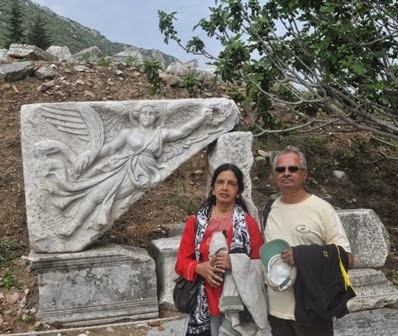GREATER FLAMINGOES
Greater Flamingoes are the famous pink birds that can be found in warm, watery regions on many continents. They favor environments like estuaries and saline or alkaline lakes. Greater flamingos are likely to be the only tall, pink bird in any given locale. They also have long, lean, curved necks and black-tipped bills with a distinctive downward bend. Their bent bills allow them to feed on small organisms—plankton, tiny fish, fly, larvae, and the like. In muddy flats or shallow water, they use their long legs and webbed feet to stir up the bottom. They then bury their bills, or even their entire heads, and suck up both mud and water to access the tasty morsels within. A flamingo's beak has a filter like structure to remove food from the water before the liquid is expelled.
They can reach up to 5 feet in height. They have a wingspan between 55-65 inches. An adult flamingo’s legs are longer than its body. The flamingo’s eye is larger than its brain!! They get their pink colour from the food they eat that has carotene in it.
The Bombay Natural History Society (BNHS) has organised a Flamingo Festival on April 16th, 2011 at the Sewri Jetty. The idea of the festival is to spread the message of conservation and sensitise the public about the importance that the Sewri-Mahul mudflats hold for these birds.
So, starting at 2pm on Saturday, the festival took the shape of a mini-fair with flamingo festival banners ready to welcome birdwatchers from the Sewri railway station right up to the jetty. Last year, more than 5,000 people watched not just flamingos but also other water birds. Flamingos migrate to Mumbai from Kutch at the onset of winter and stay on till the first rains. Apart from about 10,000 to 15,000 flamingos, the mudflats also support more than 24 water bird species such as the white-throated kingfisher, pariah kite, purple heron and sandpipers.
BNHS has also identified the Sewri mudflats as an important bird area that should be declared a protected area. In fact, a few years ago, the society recommended that the proposed Mumbai trans-harbour link from Sewri to Nhava-Sheva should be shifted about 500 metres away from the proposed alignment so as to protect the flamingo habitat.
BNHS feels that it is important to protect this wetland because the chances of its conservation will increase only when more people know its importance. “Currently, flamingos and other water birds in Mumbai are facing various threats due to loss of wetlands, mudflats and mangrove forests due to encroachment, dumping of debris and developmental projects,” said Atul Sathe, spokesperson, BNHS. “Pollution along the coast from sewage, industries and oil spills further endangers them.”
I and Radhika made it to the Sewri Jetty this afternoon. Large number of persons were standing in a queue at the Sewri East station for buses arranged by the BNHS to pick them up for the short journey to the jetty. Since we were in our own vehicle we followed the bus to the jetty. I was surprised to see the crowd at the Jetty. There must have been thousands. School children had come in bus loads. Hundreds of cars were parked in the area. BNHS had arranged quite a number of telescopes in the area for the bird watchers. They had put up a tent with posters requesting public for their support for the cause and also for joining the BHNS.
We went to the end of the jetty and saw thousands of pink specks in the mud. We had taken a pair of very powerful binoculars and could see the flamingos very clearly. Such magnificent birds. They spread over the entire area. The mud flat was more pink than black. We watched them for nearly half an hour. Even though I had a very powerful camera with zoom lens I could not any good photographs.

No comments:
Post a Comment